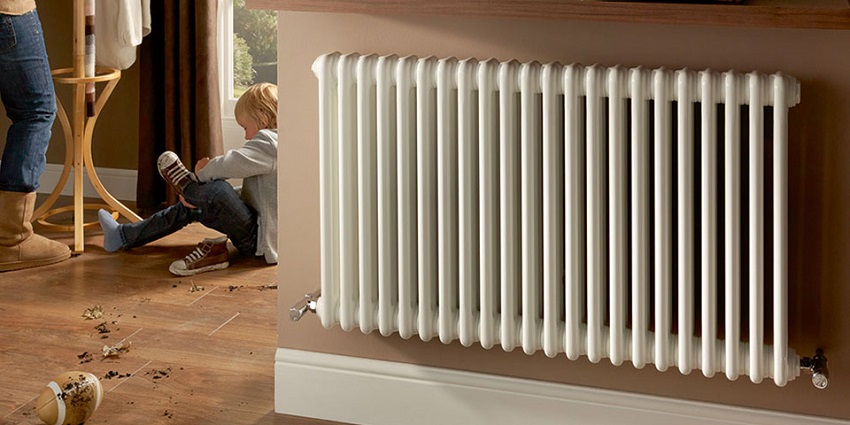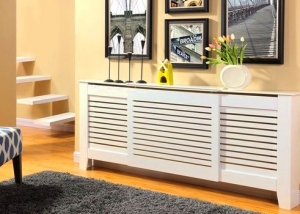Any painting inside the living room is a serious topic, since no one is interested in caustic fumes and sticky coatings. The question is not which paint is better or worse, but what is suitable or not suitable for processing batteries. High-quality quick-drying paint for radiators should be odorless, lay down well on a metal surface and tolerate high temperature perfectly.
Content
How to navigate the range of paints and varnishes
The Russian building materials market is replete with offers for imported and foreign products. However, you can’t go to the supermarket, buy the first train and cover the radiators. For convenience, modern products have a classification and description of the main parameters. The main division:
- varnishes and paints for outdoor use;
- interior paints (for interior use).
Each coating is designed to process certain materials. For example, varnish or wood enamel is not suitable for painting radiators. In addition, any surface is pre-treated with a specialized primer so that the paint does not curl, cling, or darken from a reaction with the surface.
There are conventional coatings and heat resistant. Of course, paint for radiators belongs to the second category. On a jar with a heat-resistant coating, the temperature limit must be indicated in degrees - 80, 100, 120 or 150. You can also process it yourself metal products under the coolant, and adjacent surfaces.
Important! Before painting even the highest quality paint, old pipes and radiators must be prepared in advance - to clean places that have begun to burp, peel and rust. To avoid these troubles later, it is important to choose a specialized heat-resistant paint for radiator coating.
In a living room, it is important that, after repairs, the smell of paint is non-toxic and quickly disappears during normal ventilation. This is especially important in the room of allergy sufferers or asthmatics. But for ordinary people it is nice when the batteries dry quickly, do not stick, and right after the repair you can forget about the problems with painting. Therefore, the right choice of coating is so important.
Which radiator paint manufacturers should you trust?
Odorless quick-drying enamels, for obvious reasons, have become leaders in goods for finishing and repair work. An example is the Optimist domestic enamel for painting radiators and heating and metal pipes, designed for temperatures up to 100 ° C. It does not turn yellow over time, since it contains titanium white. A dense film resistant to mechanical damage and abrasion is a guarantee of high aesthetics in the interior.
Finnish paints with the Tikkurila logo (Tikkurila, Finland) and German JOBI are also in constant consumer demand. One of the best examples is Termoaquaemail or Thermoquaemal acrylic based radiator coating.
The main varieties of paints for radiators
The modern market offers such interior paints:
- Quick-drying nitro enamels were once very popular, but they have a persistent pungent odor. It was possible to use them for painting batteries at the repair stage, when no one was living in the room temporarily. Now there are similar enamels with a less unpleasant odor.
- Oil paints based on drying oil are also a thing of the past, although they were most popular for any work inside the house. Their disadvantage is the loss of external qualities, they turn yellow, crack and lose their luster.
- Alkyd enamels with improved properties are quite acceptable paints for radiators, heat-resistant, but not odorless. Excellent adhesion to a metal surface, especially on a primer. Forms an even semi-glossy surface. The white spirit included in their composition does not evaporate for so long, it has a specific smell that can occur during a sharp jump in temperature.
- Acrylic-based enamels (acrylic and acrylate) are most applicable in the repair of communications and heating radiators. When hardened, the surface of the battery resembles smooth plastic, which looks great after replacing windows. They do not have the specific smell that the rest of the proposals for paints and varnishes possess.
Attention! When buying paint, it is worth checking the instructions on the label for temperature indicators and the possibility of using it for batteries so that you do not have to “sniff” and look for a source of smell in the heating season!
Popular brands of paints for radiators
RadiatoPaint is a Dutch-made acrylic enamel. White gloss, beautifully and evenly lays on the surface of the batteries, almost does not smell like solvent, tolerates a temperature of + 90 ° С. The capacity of 0.75 liters costs from 500 rubles.
DUFA Heizkorperlack - German-made alkyd enamel with an excellent coating, does not turn yellow over time. It differs from analogues in almost the absence of smell, it is well diluted with turpentine and white spirit, if you need to make the second layer a little thinner. The capacity of 0.75 liters costs from 350 rubles.
Convenient for independent processing of radiators, American paint in a High Heat aerosol can. It lays down on a metal surface evenly, does not leak, can withstand temperatures up to 650 ° C, therefore it is possible to process surfaces adjacent to the boiler. The price pays off - from 1 thousand rubles.
Inexpensive and high-quality Russian enamel for painting batteries based on glycerophthalic resins Alpa Alpalak. Adapted to temperatures up to + 120 ° С. It does not turn yellow (provided it is applied to the primer), does not crack, it is well washed with abrasive particles, resistant to detergents and high temperatures. A half-liter can costs from 300 rubles. From domestic offers, it is also worth paying attention to Dulux Master Lux Aqua paint and Unipol T-brand primer, Enamel VD - AK 1179 and Colorika Aqua primer.
Important! The cans of paint purchased at dubious retail outlets do not guarantee quality and special properties, since today many fakes of Chinese and domestic production are produced. And if Termoaquaemail or Tikkurila is written on the label, it is not a fact that these European manufacturers have anything to do with the strange fetid liquid inside the package.
Buyers of paints for radiators on the forums come to a consensus that it is recommended to apply any enamel to the primer. Even if it is a high-quality American aerosol or the most affordable acrylic or alkyd enamel of domestic production, it is important to follow all recommendations for storage, application and operation.









